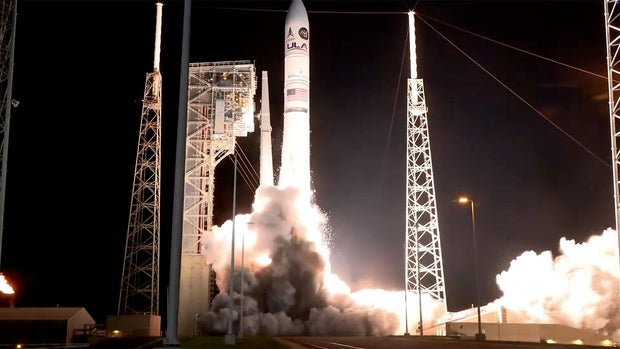Top Stories
United Launch Alliance’s new Vulcan rocket blasts off on first Space Force-sanctioned flight

United Launch Alliance fired off its first operational Vulcan rocket Tuesday, boosting two military satellites into space in the first U.S. Space Force-sanctioned flight of a new launcher that eventually will replace the company’s Atlas 5 and already-retired Deltas.
Equipped with four solid-fuel strap-on boosters for additional takeoff power, the 198-foot-tall Vulcan’s two methane-fueled BE-4 engines thundered to life at 8:56 p.m. EDT, instantly propelling the rocket away from pad 41 at the Cape Canaveral Space Force Station.
United Launch Alliance
Arcing over the Atlantic Ocean on an easterly trajectory, the Vulcan put on a spectacular sky-lighting show as it roared aloft atop nearly 3 million pounds of thrust and a jet of brilliant exhaust visible for miles around.
The four strap-on boosters were jettisoned about 90 seconds after liftoff, followed three-and-a-half minutes later by burnout and separation of the Vulcan’s 109-foot-tall first stage.
The Centaur second stage’s two hydrogen-fueled Aerojet Rocketdyne RL10C engines ignited and took over from there, but in keeping with standard policy for military missions, ULA ended its launch commentary at that point and the rest of the flight was carried out in secrecy.
At least two satellites were believed to be on board: one fully classified spacecraft and an experimental satellite that will carry out tests of upgraded atomic clocks and navigation technology that could lead to more accurate, jam-proof Global Positioning System-type data for military and commercial users.
Both satellites were bound for geosynchronous orbit 22,300 miles above the equator, where spacecraft take 24 hours to complete one orbit, thus appearing stationary in the sky.
Air Force Research Laboratory
GPS satellites operate in 12,500-mile-high orbits, but Navigation Technology Satellite 3, or NTS-3, will operate from its much higher perch using an advanced phased array antenna that can electronically direct signals to receivers in multiple locations across broad regions.
Air Force Research Laboratory
It is the Pentagon’s first experimental navigation satellite since GPS precursors were launched in the 1970s. Along with the NTS-3 satellite, designed and built by L3Harris Technologies, the program includes a ground-based control system and receivers linked by software that enable rapid reprogramming as needed for upgrades or to utilize different signals.
“GPS is such an integral part of our lives today,” said Joanna Hinks, a senior aerospace engineer with the Air Force Research Laboratory at Kirtland Air Force Base in New Mexico. “You probably all use it in ways that you didn’t even realize throughout your morning.
“And with NTS-3, we are going to be experimenting with a number of different technologies that look at how we can continue to evolve and augment GPS to make sure that it remains the gold standard that our warfighters need.”
While the major goal of the flight is launching the USSF-106 payloads, the launch marked a major milestone for United Launch Alliance.
It was the third launch of the powerful new Vulcan after two test flights last year and the first to be “certified” by the Space Force to carry costly national security spy satellites and other expensive military spacecraft.
Spaceflight Now
“This mission is headed directly to geosynchronous orbit and will be one of our longest missions to date,” said Gary Wentz, ULA vice president of government and commercial programs. “This is the sole purpose of this vehicle. It was purposely designed to support these missions doing direct inject to geo for the Space Force.”
The Vulcan is replacing ULA’s already-retired Delta family of rockets and the venerable Atlas 5, which is powered by a Russian-built RD-180 first stage engine. Criticism of ULA’s use of Russian engines for launches of American military satellites and NASA spacecraft helped fuel congressional pressure for a new all-American launcher.
Thirteen Atlas 5’s are left in ULA’s inventory, all of them slated for civilian launches as ULA, a partnership of Boeing and Lockheed Martin, transitions to an all-Vulcan fleet.
In the meantime, SpaceX dominates the world launch market with its partially reusable and highly successful kerosene-fueled Falcon 9 and triple-core Falcon Heavy rockets. So far this year, SpaceX has launched 97 Falcon 9s.
But ULA President and CEO Tory Bruno said the Vulcan’s first stage, using high-performance BE-4 engines provided by Blue Origin — owned by Amazon founder Jeff Bezos — and its high-power Centaur upper stage make the rocket particularly well suited for launching heavy military payloads into hard-to-reach orbits.
“It is specifically designed for these exotic orbits that are primarily for the government,” he said. “And this particular mission is the quintessential example. It is a direct injection to geosynchronous orbit. That means that it is a very, very long-duration mission.”
He said the first stage is, in effect, delivering the Centaur to space with a full load of propellant “to go from LEO (low-Earth orbit) to somewhere else, like all the way to the geo belt, which is 20 times higher up. And what that translates to in capability (is) certainly more mass and more accuracy than is easily done by others.”
While he didn’t mention SpaceX or its Falcon Heavy by name, or ULA’s retired Delta 4 Heavy, Bruno said “if you’re a typical three-core heavy launch vehicle and … really derived from a vehicle optimized for that LEO mission, you’re going to have to have three cores to get out there, and you’re going to have to expend all of them.
“And here’s the really complicated rocket science. You know, one core is cheaper and more efficient than three expendable cores. It’s literally that simple.”
That, coupled with the high-energy Centaur upper stage, gives ULA the capability to launch heavy payloads directly to high orbits without requiring satellites to use their own thrusters — and limited propellant — in transit.
ULA is expanding its ground infrastructure and expects to launch nine flights in 2025, reaching a cadence of two per month by the end of the year. The company expects to launch between 20 and 25 flights in 2026.
Top Stories
Aid flotilla with Greta Thunberg set to sail for Gaza to ‘break illegal siege’ | Greta Thunberg

A flotilla carrying humanitarian aid and activists, including Swedish climate campaigner Greta Thunberg, is due to leave from Barcelona on Sunday to try to “break the illegal siege of Gaza”, organisers said.
The vessels will set off from the Spanish port city to “open a humanitarian corridor and end the ongoing genocide of the Palestinian people”, said the Global Sumud Flotilla.
They did not say how many ships would set sail or the exact time of departure.
The flotilla is expected to arrive at the war-ravaged coastal enclave in mid-September.
“This will be the largest solidarity mission in history, with more people and more boats than all previous attempts combined,” Brazilian activist Thiago Ávila told journalists in Barcelona last week.
Organisers say that dozens of other vessels are expected to leave Tunisian and other Mediterranean ports on 4 September.
Activists will also stage simultaneous demonstrations and other protests in 44 countries “in solidarity with the Palestinian people”, Thunberg, who is part of the flotilla’s steering committee, wrote on Instagram.
As well as Thunberg, the flotilla will include activists from several countries, European lawmakers and public figures such as former Barcelona mayor Ada Colau.
“We understand that this is a legal mission under international law,” leftwing Portuguese lawmaker Mariana Mortágua, who will join the mission, told journalists in Lisbon last week.
Israel has already blocked two attempts by activists to deliver aid by ship to Gaza, in June and July.
In June, 12 activists on board the sailboat Madleen were intercepted by Israeli forces 185km west of Gaza. Its passengers, who included Thunberg, were detained and eventually expelled.
In July, 21 activists from 10 countries were intercepted as they tried to approach Gaza in another vessel, the Handala.
Top Stories
No. 9 LSU outlasts No. 4 Clemson as Garrett Nussmeier outduels Cade Klubnik in top-10 showdown

No. 9 LSU went on the road and shocked No. 4 Clemson 17-10 to pick up a crucial road victory and firmly cement its place in the national championship picture. The battle went down to the final minutes, but LSU coach Brian Kelly finally picked up his first season-opening victory as Tigers coach.
Tied 10-10 at the start of the fourth quarter, LSU quarterback Garrett Nussmeier put together a legacy drive. After he was roughed on a completion to Aaron Anderson, Nussmeier ran for a third-down conversion and then found tight end Trey’Dez Green for an 8-yard touchdown to give LSU a lead it would never surrender.
Clemson had three more chances to get back into the end zone, turning it over on downs once and going three-and-out to set up a pivotal final drive. Clemson quarterback Cade Klubnik completed a big-time pass to T.J. Moore while taking a shot to lead a drive into the red zone. Facing fourth-and-4, LSU defender Harold Perkins brought pressure and forced an incompletion to end the game.
Playing against a phenomenal Clemson defense, Nussmeier stepped up big, completing 28 of 38 passes for 230 yards and a touchdown in the win. Anderson was his top target, catching six passes for 99 yards, including a 39-yarder. Running back Caden Durham went for 74 yards and a touchdown. Klubnik was strong, throwing for 230 yards, with four receivers hitting four catches. However, the lack of running game (20 carries for 31 yards) stood tall in the biggest moments.
Read on below for takeaways from LSU’s season-opening win over Clemson on Saturday.
Top Stories
Powerball jackpot jumps to an estimated $1.1 billion after no winning tickets in Saturday’s drawing

The Powerball jackpot has risen to an estimated $1.1 billion, the fifth-largest ever in the game’s history, after there were no winning tickets for Saturday night’s $1 billion grand prize.
Saturday’s winning numbers were 3, 18, 22, 27 and 33, with a Powerball of 17. There were nine tickets that matched all five white balls to win $1 million, but no ticket matched all six.
The $1.1 billion jackpot for Monday night’s drawing has an estimated cash value of $498.4 million.
Based on the jackpot estimate, a single jackpot winner Monday would have the choice of taking a lump sum payment of $498.4 million before taxes, or going with the annuity option, which would consist of one immediate payment followed by 29 annual payments that increase by 5% each year, each payment also before taxes.
Saturday’s drawing marked the sixth time in the game’s 33-year history that the top prize has climbed to the billion-dollar mark.
No one has won Powerball’s jackpot since May 31, when a single ticket in California won a $204.5 million jackpot with a cash value of $91.6 million.
Four of the five previous billion-plus-jackpot-winning tickets were sold in California, including a single ticket sold in Altadena in 2022 that claimed a $2.04 billion jackpot, the largest in both Powerball and lottery history.
The next drawing, which takes place from the Florida Lottery live draw studio in Tallahassee, is on Monday at 11 p.m. ET. Tickets are $2 and are sold in 45 states, the District of Columbia, Puerto Rico and the U.S. Virgin Islands.
contributed to this report.
-
Tools & Platforms3 weeks ago
Building Trust in Military AI Starts with Opening the Black Box – War on the Rocks
-

 Ethics & Policy1 month ago
Ethics & Policy1 month agoSDAIA Supports Saudi Arabia’s Leadership in Shaping Global AI Ethics, Policy, and Research – وكالة الأنباء السعودية
-

 Events & Conferences3 months ago
Events & Conferences3 months agoJourney to 1000 models: Scaling Instagram’s recommendation system
-

 Business2 days ago
Business2 days agoThe Guardian view on Trump and the Fed: independence is no substitute for accountability | Editorial
-

 Jobs & Careers2 months ago
Jobs & Careers2 months agoMumbai-based Perplexity Alternative Has 60k+ Users Without Funding
-

 Funding & Business2 months ago
Funding & Business2 months agoKayak and Expedia race to build AI travel agents that turn social posts into itineraries
-

 Education2 months ago
Education2 months agoVEX Robotics launches AI-powered classroom robotics system
-

 Podcasts & Talks2 months ago
Podcasts & Talks2 months agoHappy 4th of July! 🎆 Made with Veo 3 in Gemini
-

 Podcasts & Talks2 months ago
Podcasts & Talks2 months agoOpenAI 🤝 @teamganassi
-

 Mergers & Acquisitions2 months ago
Mergers & Acquisitions2 months agoDonald Trump suggests US government review subsidies to Elon Musk’s companies
























